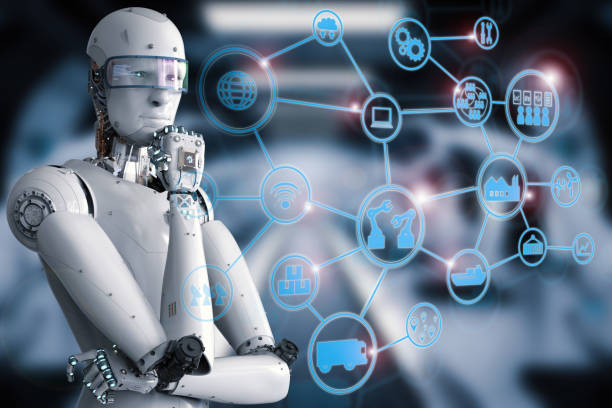Introduction
The rapid advancement of artificial intelligence (AI) and robotics is reshaping industries across the globe. From performing complex surgeries to optimizing production lines, AI-powered robots are increasing efficiency, reducing costs, and improving precision. As industries embrace automation, AI robotics is driving innovation in sectors such as healthcare, manufacturing, logistics, and customer service. In this article, we explore how AI-powered robots are transforming different industries and what the future holds.
AI in Healthcare: Enhancing Medical Precision
AI-driven robots are revolutionizing healthcare by assisting doctors, improving diagnostics, and enhancing patient care.
1. Robotic Surgery
Surgical robots like the da Vinci Surgical System allow surgeons to perform delicate procedures with enhanced precision and minimal invasiveness. These AI-powered systems reduce the risk of human error, speed up recovery times, and improve surgical outcomes.
2. AI Diagnostics & Imaging
AI robots are being trained to analyze medical scans and detect diseases like cancer, Alzheimer’s, and heart conditions with incredible accuracy. IBM Watson Health and Google’s AI-driven DeepMind Health are helping doctors diagnose diseases faster than traditional methods.
3. Robot Caregivers & Assistants
Companion robots like Paro (a robotic therapy seal) and Pepper (a humanoid robot) provide emotional support and help elderly patients with daily activities. AI-powered exoskeletons are also assisting paralyzed patients in regaining mobility.
AI in Manufacturing: Increasing Efficiency & Reducing Costs
The manufacturing industry has been one of the biggest adopters of AI-powered robots. These robots are making production lines smarter and more efficient.
1. Smart Factories & Automation
AI robots in manufacturing facilities are improving productivity through automation. Companies like Tesla, BMW, and Foxconn use robotic arms for assembling, welding, and quality control. These robots work faster than humans and reduce errors.
2. Predictive Maintenance
AI-powered robots can monitor machinery performance and predict when maintenance is required. This prevents costly breakdowns and downtime, saving manufacturers millions of dollars.
3. Human-Robot Collaboration
Unlike traditional industrial robots that work separately from humans, collaborative robots (cobots) work alongside employees to perform repetitive tasks, improving safety and efficiency. Universal Robots and ABB Robotics are leading the development of cobots in various industries.
AI in Logistics & Warehousing: Faster, Smarter Operations
AI robotics is transforming logistics and warehouse management, making global supply chains more efficient.
1. Autonomous Drones & Delivery Robots
Companies like Amazon and FedEx are experimenting with AI-powered delivery drones and robots to automate last-mile delivery, reducing delivery time and costs.
2. Smart Inventory Management
AI-powered robots like Kiva (now Amazon Robotics) efficiently manage warehouse inventories by automatically retrieving and restocking items, reducing manual labor and optimizing space.
3. Autonomous Vehicles in Logistics
AI-driven trucks and self-driving forklifts are making warehouse and transportation operations safer and more efficient, reducing reliance on human drivers.
AI in Customer Service: The Rise of Chatbots & Humanoid Robots
AI-powered robots are revolutionizing customer service in hotels, banks, and retail stores.
1. AI Chatbots & Virtual Assistants
Companies like Google, Microsoft, and IBM are developing AI-powered chatbots that provide instant customer support. AI-driven assistants like Siri and Alexa are helping users with everyday tasks.
2. Humanoid Robots in Retail & Hospitality
Robots like SoftBank’s Pepper are being used in malls, hotels, and banks to greet customers, answer questions, and enhance customer experience.
3. AI-Powered Self-Checkout Systems
Retail giants like Walmart and Amazon are using AI robots for automated checkout systems, reducing wait times and improving shopping efficiency.
The Future of AI-Powered Robotics
The integration of AI and robotics is still in its early stages, and the future looks even more promising:
- AI-powered robots in space exploration, assisting astronauts on deep-space missions.
- AI-driven autonomous farming robots, increasing agricultural productivity.
- More advanced humanoid robots, capable of human-like interactions.
As AI and robotics continue to evolve, industries will experience greater automation, efficiency, and innovation. While concerns about job displacement exist, AI-powered robots will create new job opportunities and transform the way humans and machines collaborate.
Conclusion
AI-powered robots are revolutionizing industries, from healthcare to manufacturing, logistics, and customer service. These intelligent machines are making operations smarter, safer, and more efficient. While challenges like ethical AI use and workforce adaptation remain, the future of AI robotics is filled with exciting possibilities. Embracing AI-driven automation will not only enhance productivity but also open doors to a new era of innovation and technological advancement.

